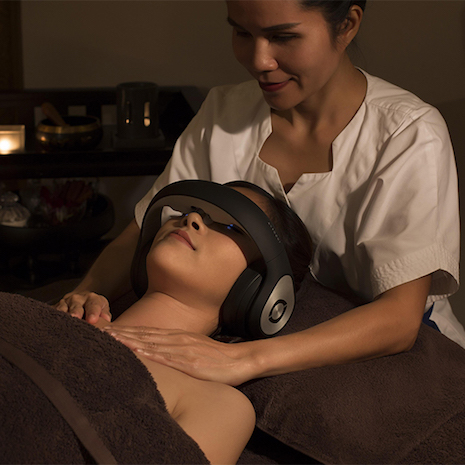Wellness is a particularly important aspect of the luxury sector and its popularity is continuing to take off, with the industry growing 12.8 percent in the last two years.
A new report from Global Wellness Institute shows that the industry jumped from $3.7 trillion to $4.2 trillion over two years from 2015 to 2017. In the same period, the wellness economy grew at double the rate of the global economy, pointing to opportunities for the luxury business.
“Once upon a time, our contact with wellness was occasional: we went to the gym or got a massage," said Katherine Johnston, senior research fellow at GWI. "But this is changing fast: a wellness mindset is starting to permeate the global consumer consciousness, affecting people’s daily decision-making – whether food purchases, a focus on mental wellness and reducing stress, incorporating movement into daily life, environmental consciousness, or their yearning for connection and happiness."
Wellness economy growth
The wellness economy grew 6.4 percent annually from 2015 to 2017, compared to the 3.6 percent increase for the global economy.

Spa services in wellness are becoming extremely popular
Wellness expenditures now make up more than half of global health expenditures, at $4.2 trillion and $7.3 trillion, respectively.
The wellness industry also currently represents 5.3 percent of the global economic output.
Spa facilities were the fastest growing sector in the wellness economy from 2015 to 2017, rising 9.8 percent.
Wellness travel follows spas, increasing at a rate of 6.5 percent within the past two years. In 2017, travelers embarked on 830 million wellness trips, and the market for wellness tourism has reached $639 billion.
About nine in 10 wellness travelers do not plan their entire vacation around health-conscious activities, but rather seek out ways to partake in activities or maintain their lifestyle while they are away. This may mean finding healthy food or joining in a fitness class.
Wellness-focused travelers also tend to outspend other travelers.
North America has the largest wellness real estate market, valued at $54.8 billion, with Asia-Pacific following at $46.8 billion and Europe coming in third at $31.7 billion.

Money's on health
Workplace wellness is also growing dramatically, with North America leading the charge in that as well. Fifty-four percent of North American workers have access to workplace wellness programs in 2017.
However, only 10 percent of the world’s workers have access to such programs and services. Europe follows North America with 25 percent of workers able to access wellness solutions.
Additional insight
As consumer spend on health and wellness grows, the luxury industry is getting in the game.
Once a trend, the notion of athleisure is now becoming part of a broader lifestyle, extending into areas of consumers’ lives beyond fashion. In a webinar presentation on March 2, analysts from Euromonitor discussed “The Future of Athleisure and Luxury Apparel,” looking at how the two are increasingly colliding (see story).
While wellness continues to be a vital aspect of luxury travel brands' experiences, the face of the health movement has shifted.
With affluent travelers' interest in health and wellness becoming an important feature in selecting their next trip, high-end hospitality brands have been forced to embrace it. However, in the past brands and consumers were more focused on fitness, but now digital detoxes and mental health are becoming more popular in catering to today's overly connected affluent (see story).
"Wellness for more people is evolving from rarely to daily, from episodic to essential, from a luxury to a dominant lifestyle value," Ms. Johnston said. "And that profound shift is driving powerful growth.”
{"ct":"ycArGTN9C90y3GNC2gTQgcuF578RlWnfHpK\/\/NOvqFflvzBch7SUjxmHstXBQLFoQpsM5arCFlmnFojGfd3AKe0QL95RFixMyZjCW42r1xS7g0omUFByUl9xg3Qo+n2TuGpys3W7doqqo2URooaG2AipsbdcHfx8gMFXcq2NNTKxWMauzXCtXQLyeRgH6ca00GURt8YcdWTKNg\/k+hsBa\/xOtmhKYaKLYjIsCCk+NnIR6vKNTEfnp0TFap\/+NpIFk8Sq6pwz9NkVKXt83dwMZ3AKYmOXh45GqIqtQsERnCLqVVAq4mo0BA0mlFhbXVPRfr6cXeYKjn1MZEYkwDIX4qigC7Ta7pwoGtSt2qmqRQ1x1SYO2lT4wHZkRNAK0VY173jeINiApVAuVmS\/+bYWgP5B7fqk\/xWQ6g7dRZfDfzWTzMTKCGqpHxPgnix6c0gdtcQWX4gDc1KO8rJ6\/+4kpSnL8NsfgtbmSy5pW4+13Ra1HwS+o93TJJel+tFb5tTS+szQNu8pmP+X7+ma+aDAZJf5i7n8NcC6E5i8UHeAWnnGtNP1Y\/g2xUXd2ZsoIiqMjmbL7aL\/Uy0BNfkdivMFPGLkuOGtp\/u5Wg7y4jGNxI48CLNzoBAZRRJqVLGDLSuKsbR0x2f1aTYPL6T7qQ2N\/ZLg0kcfwSgFCvqigdHsg5ecnQ8tJEx+xudsUTu8cNOXM97NcB0033l+az8qTZPsIWHL6Umw3bbLf4D9PseXzy1HSmfUL2IO3k3rAlUIrXtD0cq7oY+2Fiz1JolQVG3fq7grLT+242y\/X3yj4y73fhehpJjff\/NDuImOUu+EWdo2or7DJroFnee44qCXVIa3plUJVAwb8qyUfrQkOC297u2+8ToEsJNt4Ef6FBCP1WBX8nwJ2JLQqDquSHkx\/scvgPR3y7hQaLrkdgaSLGLT9hde789BRdx3OLzwQucKc9SLvzrW8rr9Yub4Varuh4ffcSv4mKxbV0sT2ozxt44lGnFjRXxn6guhtZgdaA4pSM2pdfFQz5jx3J4Dus5yr9+jc1RC9Oxufv+pqRyL\/myUzhctqIXGNxXxhmeL5FqMho97BLfaUoXe4XtxlephZw6JM1ErBEgVmbFizUYF18ebt39J40MqO0Kwz8rE1z6XKwEUgRIJPnnOF4S3n0N3boWYFmr0oseJ+2ITgd8+O4HcLOoFCRAUvCv\/nQ5ZpaJ30YoYtVB+z1DNA3gta1jCzakoJmM6fi4uoXmufe26k97X\/\/pKHIMjmIABuay4cm\/cI\/pL+clrq55YgXxcpatDlfWCM1NMhYQyoTwABjp07iSstRJ9PoopLZlZPVfDFDhkgrlEM3xUKztTdM4YGQEoHNc9tuUkPMwE2qUlWVP0P5j4W6X2PpNkwNTn6r7W2\/UOEAUFGFVyGB\/hO7pe+TG8lj+fwkgS6icEpKlBYU51zSLhfQ7cCAIWFlc3rnHjGDeR3xGTa9RJSCVmidjcAJLs7GU2VszADriHZvr54Lg2AdFZtkcowDJssyJjNfrANZQyiz86z7yegXYuCJOOSBk1mk2BJSv7CJiTdjCWd0Q6hIuCDh7y2iSS9pNL90twodPy3wziK5T9RRRbGKDuu9U6teGH9RH1182bpLOllJVwEGcmt4Qbu6Fhcbs60KvluQku+UVL4KnA8PtEy6s+d1sXk2M\/PqB26ZNHWieBAt925waDKHdPlOJwbeDJt3rm1AEqf+RluUC0+dieG6jGk0pggo\/fbrh555lN65XnPa8Ha0hSk4xaM+XIlhhOw7zdWXLETXG0DdHvzaMTQwAR4U99fdEkvtr1Jv60zGLYIDJdyLRErmQQQjczKMOyCuyS3H+8dFx+z5Mii\/lIp2x4JeOjEPLGMxBVdVoGCNjKqhj9MMG7eR0B3fIsHhH67SOkx93LysLeC7tOb2TKXZeC73fg4GulVK+Yf4MnxJ9ScflEuI3xNT3kRMVEorNtS8ZNEPFSAVIyxKOiNX+KidsbmefCbaH4i4kkrsydTfrScXN33H4c2CKQ4BS5lLlEevyjfOO\/j+\/xtvfvYEsljhHUDdpTcdvV0skTMZlVYVNwfV5GUeTKLY4BrvOCJkiEJBeCnRHl4hBHa+\/VE6coUdkdvbjrNxXF7mdLZpJxly+3UlpZXzpYLUUwjaNVqgtiHgf+KUBD0qjAiqQo6bsXy+n+R83zV8HgtAkBy0QJKz2gaFqNAywkNilusJhKHde3cMAw4Dp6IRSvpY5ftXn0DOR+tK4EgBMh6\/XRDfZugQoXoYGOp2zko2dIBUvP+uZLiP1cAHmBeYIMtdeKFkimHGCMeqYJYFIzOoDLvCs6k0sQfsjgJhD+tT68Ll2jsepiigY2kqXb6c5LzsKklgNeYfwq7CjCEA3k9c5WGBK9iqkONIMrPEnLyCZTnjfrStiGVigJQu8R1rObXJfJheEyd4PnxYqTDPlc0+RQazm0g+wf2QCDzx0c9YmYcvtUH7RgqEm6Xb252yyyOsStkj9d60KgR6q9ot1sT9iT+4BVMqlZNYQMzGbwuNYFqEBlQkcq1h9mV2rhhWXMrrO\/FUeFZy2hOu+P4Tg\/A3I+b7PLfKdVmvD8Vb36qECuOIk2sR820JGuHD\/akWDAFAlk79jaWW\/QG7asKnUz+cGwwnhSX\/tZavzdK+olqP+gv9vlMz4mgQ\/Jmvl85pKQvCUamfZZ0yJb9+68283y7yIsHM1h8eUf\/N\/iKCT1UFbCYU0vV9B6+oz9k4BlCard4NfVdg4dmM8kvXBVJcV73YD1DIaYimoypJQ+ofBOsQ8ylftuD6UMfQ5WhlMuH+FX7KACKXS9F932f4jehXt1WHpHaWvwt+gKnxrI2Em\/Vnf\/FoS7PuMR4SEMvTS4LQsh0h8fRwuJdZZ9Ps9vNxV85D\/9pcj7VEvcR7dX4bXoWha\/npkSoHBNkbMfwUWAdXMGuwQw8AUM8FFDqxa6FPr5woBccfd0mFzk5aZWpiqQ\/RnVcz8OemJEEgfd66QsZi0PzsD7r1L7QMKndalHyns3hEg9\/5nhr8ssUB8zjeiZOYax\/pkepPPMwYxBEegbLsMr70SY4IFja5ZbdJAhk7Nz7eG1BMdLOTkDUqzcWKn8K74tIgJtT\/11WCAvkpucS\/wykz6WHYkSqmB2zTCOZ6BennmhSAVskfBCfzflxICAm\/WMWqARTt\/+9epSalxDdXxnb0dqPhIgK+BItSVvI9arOuwdNAXdDD5Ub0fJaYzhHg65vs5ypIQNMRK64l4dRaaxB2tBvADOlk\/1JtRQYIsQWp1asEyIn8dlEz5OXHr2hexuMsUAdByfU4HULCH2mpeUrIkE04Pyj5QsRlXc+BMoiORsKdRH5b7OeOi+IdEeFHnimDrxnm45kkKhfYUWb0jDAZ+SOsjO72gT\/YlbnlRv1RY6VtMayrbgylNJvcVGu5PNyIwulXdem3cc9UxIDRgc1N9RKIvJDwzwWtEvr73gG7liY7i1NmOYQy7ugMKGBAzvdK4wSdb7WPw1+WX0cvRlFicRgV2HoB+tK7F5ga7dB50Giip0Nk91AYNP2jRdchI6HVoa\/f4HdM2q01JCXVrQhsOd3zlmA8zqfRPCoOY11KXYg+kv+5LNlcuxaTrL9ydRxyirfyFik62kXqBAvSiMb4LzqGOiio0m3DFY5Sdj38tCb4qmcKETa6cmsdcoBbdyeI6L21OnYaLkJ4mCXq6ssirJsy7hsBojdyFT4Pj9xymtUnq8\/HrUiCX4g\/rJoX1pNoM5bINShucxg\/nYMMfi4\/2qCs0RPvAXj7OyupD0kSiq92lTdnI\/ZuAW7kJg+8Jv3yyC3TjmmJP\/VgkN4ax1w0ToT8HWboDEBQCFP+VSWgoLLDflOYVQ91SlFT1JMgroLJJn5ETpd5qItpE5Ur+VJE2YRRs8B3RXE1eD\/EZT7bQrI2efxn3rkv7PJD4dj49Pogmu\/SL2B0tCpiSFLwu7UBVsN0nnlMHTVU0\/SDpXL3M+1ccEMzeDTTsqUxA8zf29eXYaDZzjhRt936mfxIyl8Igj1zgXLhMlXDsXxeGdBTeu4BQsRkTFg0XD+w41arIq9wW99Ubqsq48U7MfHcml2bvXsOn0Y1MWpPWx7t5u98s5w+nII+fVZ7yIAeB+TGG3QG2RT9W40BBSAKOE6VOzCHPxXCxpGYozOQobqQgghb2zQmHCMMxcfCM5v\/4qs01WYcEfkvsho5+PRq0Zvsrpg7TQxlkSIm0ix+v++FeCFXSghfLX5i7\/CFYEgg3xpBhfgll7yhHZS9VXmdwkw6KeDrJFNwb8di2XBpCu1qNvZUI2gKt9LtBgnt0gUCD2Qz8UCro7IzejFqThudY8b29mOtnMpHZb76oC6s3NPHOnz3Xabv8kOSXVPR39p71Sq6yju2m1AeaY4mAT39iJD7UmuUpnwAEZEqAazFre81EAybSnjyYANc+oWKx6jvdHcEVNVVVpjeeFDfEghpdsOeS02Wn0SuW83+tTu9L3OaWjS8o2WOChpUJDW5CkI1lZXiKXr3x6JqdKSYI9kCQayvqB5LW7mv\/moFQuLo1FifTwOgn6wybCKysSKUlTMOWyKOMJ6ECazF1hOtX+66W+aa5Dfqx85oJdyC2rQaGmbN8+XFZumUtQ8ShuVMDO1rAydb94nmgo5\/aAdIcDu6\/VJ94n0BNvaSoTrHhZOMR1rgudeXXPoY6rhyVv88uoC9iuYImnbnh388wQbrhyb8h\/a0nnInWR+Z4vMuTIGwn8alfCEsa8vaDN8NOlms8c22iOjIs7zfqOlq3bXWVQRQ+pk5YgrfRkRVFcm+A4g2KlaSRYm+wH2r1CFYJxVrNJ7UB22H9pkkFyHLR28W8AES570aaLvU1Y6c4Rb4f1OXmowo\/FM33AtvxtfO1VQaoPar0qRDwgqcRZM1d2C3EHtiOoKj5oHvV18C+3WpPU1ftd5Rcc5LmZoGIZIQ2rAZ2YKgoaYUDQW4bfwQRseokdRiSqwX1LYugsA86FcRQvtUbGuAUPww7897UsngUXR45jCrroGZT1kCwOzY8pLMCrVPRLxusKVQGsrz0KobdMsnJ2lS6LdnO9Wa1jy45\/r7GDUrhAGHR5\/Mvd91keBjdihaiNKyCTeMT49aXZf74JrP\/dWub+bwEDiLqiUieQ6L4zgNhR4nn82daOTMlDL3nSgztlMmjELGviB\/gKiJpzyGR8TFJXpwR5DPym4cpHI4J72dwqm\/pnAKhfkFzxgceCnT2xVtcB7UiyawVWGSVhXLnPvgjKsHrpX6eAD5QG++4iGuEIjGh4EGhgd1UFkOL5\/O4tfHKbBpYTuhdDugNIZ9lifr8Pc58jyoplliIdWxkT4N2ygjzf70+spzL4t9Ugi5I5iPavnGVKPvenuLoeWBhUrjlKqK\/OcUdUf2UzgJ1ZE0vJdbvrkIRBa8ah5AqZ6P0O16FQTJnBmK\/klxKx9x42TpEBZTKLCiAZR41J8ic3WHA69FkpG\/abPDhQ4pqEIyj89U8J9MbxizqDIqihwO3zm86p8VWufa4CTe3FSKbKP1hUyD9uHsWMusYAQI6N12THk2Ob7gJ\/bFs\/lawbbFIRRZyZE9aGgbrXT9kqs0kkZnq0CFLKq+zIwoJJV3bw7TgjpdLaUo0NsEBKru+EKOqVoYka419jNBQA5gkvOoTsqASbwHASGHYVMeXul0AZNdF5jVIjIDnqjcNwKFpLbTNdELXRdeW8EPydHJ3RBmwHOAxP9qFUo3sbf9PDLH78lI+2xUONN7QjedJhOgy23Rs79ITYSw4jZicIULfyuL7DZD210ubXc5K06bgu710DDsQmwAcObXgdOlPk9TxO2TMrzx2Zmg1SazkLS00A3GmZNxsObwkzIChQ4iyQNbKApTHDR\/xtYd9MLHGYXAayveoCDyxkN5ZF\/lhsCsnOeEaGxx1CzU2SfhPtl+PLFx8cF\/0h0KQ1DtBWgl6HA7\/kSptwwMLq5dJqqXfEZGw6w5aKu6\/2GONf2T3GEXHWRNS4eXPPjm4f1Ao8Gy0VLkPNBFUer2CjKAepZJjWhjvI1SSWIjqoAIaZqhnLN4iCB5YP7nl9pjh9ACMRUg8YRG68hwnr57eTwyjQ1ij3UZY8+cImUW2gI3YvaC45c8qyvfEM2KLx+BWZvxo\/3tJtZ8SMfvnEBNBpclHS5b4rJsSZv5ZnGm1j+d6Ho+OFM7JHS2escGoJIOCR5YaeBw0F1+7B1q2CqLgNeyq7+OtBOW+OzLL4eXal\/PKJ9qzC1Fl3lEwJHKCFWS+MvcScz1ADzqhI7bPWXC2Zgwnb1a7mZBDopQVkPMJpmJZUCgYLCsPe5h2hb76ryBT6vxAUCPM4muAvdgprOwrbpDAbJvxHM0aQQnJHXAD4quKNh6J3Bz5kIGQCM3oNN1NmpG5id4HxGFE3CElkZkCOVxT05y2eTgfQzyZym+7QadIUWV3b7nvQkaotFvcpCQFXKi7g70mAMzGXCX9nCDHd7HPMOhyqOsoagpPh\/CqyG7uAcuqwHbKfxDI9igfSsmP0f80PC8ks7QuvO1BwbOMX7Rog4xUbiX\/FZ41hEShwI1pA8J1C5XOdQjvdVsEjG72\/9zI5IKPahnM8YA8X19NOqc4293cKB+jxgvN\/t3jJevcRcEoKZFsuUZDCidwKP6dCaPuJFFaTfl35FLuP9n5b41U5aQi7W0QMSlgjqRMOHF3LuDn1yONGaNkAoo11nDt59okf4U7HQLiSEZH2FSpNCU6bhetQTO03WtijCxjiFZlp8S4gbcbUxIkiCtCq46zvoy7sVL9vJf1StnJ04uit2R\/OlusZ8LnVoIW+5phpVFy+QhNb0Y9qC7GTElzSPiz0nk01vxu2nDNmhMykNOzR7Hx1vxy3YifxNFSvTTi8csDE915QVuhQkvGkxZ030Yec","iv":"d805cec6212c1e74091fe029459e5f21","s":"7607c5b73f1ef698"}

 Four Seasons awakens a mind-body spirit connection for Global Wellness Day. Image credit: Four Seasons
Four Seasons awakens a mind-body spirit connection for Global Wellness Day. Image credit: Four Seasons